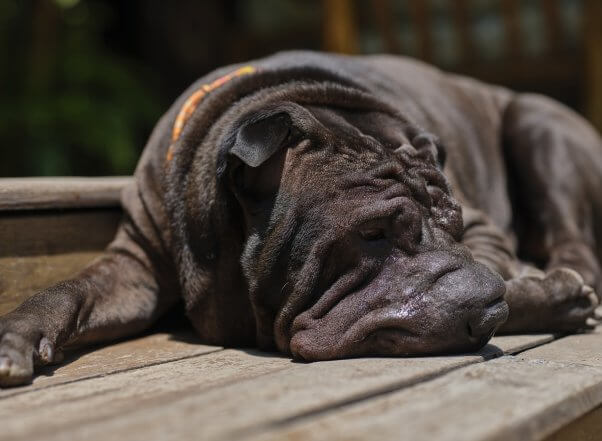Shar-Peis Are Likely to Have These 5 Health Issues
Are shar-peis a healthy dog breed? Greedy people have intentionally bred these wrinkly skinned canines to suffer from many health problems, including in-turned eyelids, shar-pei fever, and breathing issues—just so they’ll look a certain way.

What Health Issues Are Shar-Peis Likely to Have?
1. Shar-Pei Skin Folds and ‘Sandpaper Skin’ Lead to Constant Infections
In Chinese, sā pèih means “sandpaper skin,” a nod to the dogs’ rough, prickly coat. Unfortunately, Their prickly coat becomes dangerous when mixed with their excessively wrinkly skin. Because their skin folds are constantly rubbing together, moisture can become trapped in the folds and aggravate their skin and coat, leading to fungal and bacterial infections.
2. Their Eyelids Get Turned Inside Out
Nearly one in every five shar-peis is diagnosed with entropion, a medical condition in which the eyelids turn inward. In other breeds, this condition affects only one in 200 dogs.

This condition is common among shar-peis due to the excessively loose, wrinkly skin around their eyes, which makes blinking—which dogs do about 13 times per minute—dangerous. The inturned eyelids and prickly fur scrape against the front of the eye, causing irritation, extreme pain, watering, and even blindness.
3. Shar-Peis Struggle to Breathe
Shar-peis are considered a breathing-impaired breed because they are intentionally bred to have disproportionately wide soft palates.

These dogs are also prone to cutaneous mucinosis, which involves an abnormal buildup of mucin (a type of mucoprotein that occurs particularly in mucous membrane secretions) under the skin, creating lumps and bumps that can occur in the back of the mouth, impair breathing, and cause snorting and snoring.
When dogs struggle just to breathe, going for a walk, chasing a ball, running, and playing—the things that make dogs’ lives joyful and fulfilling—become difficult and even dangerous.
4. Shar-Peis Often Develop Hip Dysplasia
As they age, shar-peis often develop joint issues, such as hip dysplasia. This painful condition occurs when the hip bone becomes misaligned with the hip joint. Dogs with hip dysplasia struggle to walk and run and are eventually unable to put weight on the affected leg without surgical intervention, pain management medication, or physical therapy.
5. They Suffer from Shar-Pei Fever
Approximately 23% of shar-peis have a genetic mutation that increases the amount of hyaluronic acid in their skin. When this acid escapes into their bloodstream, their immune system triggers a fever. This can occur as often as every few weeks and often leads to kidney or liver failure. Although medication can help curb the effects of shar-pei fever, there is no cure, and many dogs who suffer from it die young.

Should You Buy a Shar-Pei or Another Type of Dog?
No. Buying any dog from a pet store or breeder purebred Shar-Pei, mix, or any other dog means a dog in an animal shelter loses a potential family. If you have the necessary time, financial resources, patience, and love to care for an animal for life (which could be for more than 15 years), please adopt one from a shelter.

Did You Buy a Shar-Pei Who Suffers From These Ailments?
Many “purebred” dogs become ill, suffer from emotional or psychological disorders, or die prematurely because of traits they were bred to have in order to meet standards set by the American Kennel Club (AKC). If you purchased a shar-pei or another AKC-registered breed who struggles with their health or psychological well-being or who died prematurely, we want to hear from you:




